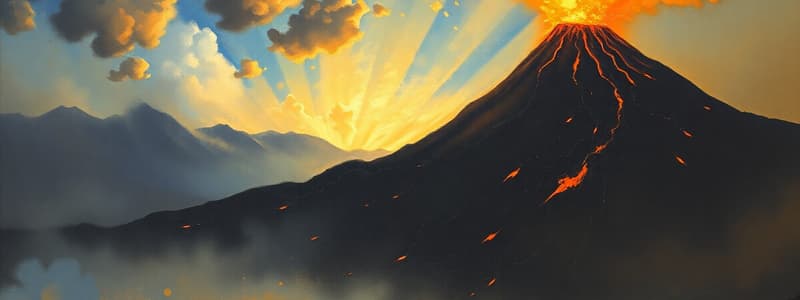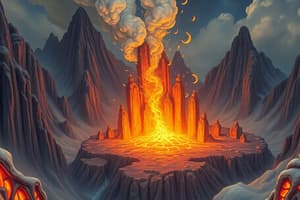Podcast
Questions and Answers
What is a caldera?
What is a caldera?
- A type of volcano with low, sloping sides
- A volcanic eruption that produces a significant amount of gas
- A large basin formed from the collapse of the ground surface associated with a volcano (correct)
- A landform created by the accumulation of cinders and ash
Which type of volcano is characterized by steep sides and layers of lavas and pyroclastics?
Which type of volcano is characterized by steep sides and layers of lavas and pyroclastics?
- Cinder Cone
- Caldera
- Shield Volcano
- Composite Volcano (Stratovolcano) (correct)
What is the primary factor that influences magma composition and volcanic landforms?
What is the primary factor that influences magma composition and volcanic landforms?
- The temperature of the surrounding rocks
- Tectonic environments (correct)
- The presence of groundwater
- The depth of the magma chamber
What defines a shield volcano?
What defines a shield volcano?
What is the status of volcanoes in general, categorized into active, dormant, or extinct?
What is the status of volcanoes in general, categorized into active, dormant, or extinct?
What is the primary relationship between volcanic activity and geological structures?
What is the primary relationship between volcanic activity and geological structures?
How does the composition of magma specifically influence volcanic eruptions?
How does the composition of magma specifically influence volcanic eruptions?
Which type of ejecta is not commonly associated with volcanic eruptions?
Which type of ejecta is not commonly associated with volcanic eruptions?
What classification refers to a volcano that has erupted within the last 10,000 years?
What classification refers to a volcano that has erupted within the last 10,000 years?
What unique method did local citizens in Heimaey utilize during the 1973 eruption?
What unique method did local citizens in Heimaey utilize during the 1973 eruption?
Which volcano is identified as having a major eruption in 1781?
Which volcano is identified as having a major eruption in 1781?
What is the study of volcanoes called?
What is the study of volcanoes called?
Which of the following statements about the Pacific Ring of Fire is true?
Which of the following statements about the Pacific Ring of Fire is true?
Which volcano type is characterized by low silica content and low viscosity in its lava?
Which volcano type is characterized by low silica content and low viscosity in its lava?
What distinguishes composite volcanoes from shield volcanoes in terms of gas content?
What distinguishes composite volcanoes from shield volcanoes in terms of gas content?
Which type of volcano is known for having the highest viscosity lava?
Which type of volcano is known for having the highest viscosity lava?
Which lava flow characteristic is commonly associated with shield volcanoes?
Which lava flow characteristic is commonly associated with shield volcanoes?
What is the typical explosivity of caldera eruptions?
What is the typical explosivity of caldera eruptions?
Which of these characteristics describes the lava of composite volcanoes?
Which of these characteristics describes the lava of composite volcanoes?
Which volcano type generally forms over long periods due to repeated eruptions?
Which volcano type generally forms over long periods due to repeated eruptions?
What type of lava flow is associated with caldera eruptions?
What type of lava flow is associated with caldera eruptions?
What type of volcanic activity is associated with divergent plate boundaries?
What type of volcanic activity is associated with divergent plate boundaries?
Which of the following is a characteristic of shield volcanoes?
Which of the following is a characteristic of shield volcanoes?
Cinder cones are primarily composed of which material?
Cinder cones are primarily composed of which material?
Mount Fuji is classified as which type of volcano?
Mount Fuji is classified as which type of volcano?
What geological feature is formed from the accumulation of numerous lava flows?
What geological feature is formed from the accumulation of numerous lava flows?
What is the main driving factor for hot spot volcanism?
What is the main driving factor for hot spot volcanism?
Which type of volcano typically has the smallest height?
Which type of volcano typically has the smallest height?
What type of volcanic eruptions can generally be attributed to composite volcanoes?
What type of volcanic eruptions can generally be attributed to composite volcanoes?
The Columbia Plateau is formed from which type of volcanic rocks?
The Columbia Plateau is formed from which type of volcanic rocks?
What tectonic activity leads to composite volcanism?
What tectonic activity leads to composite volcanism?
What characterizes a dormant volcano?
What characterizes a dormant volcano?
Which of the following is a property of more viscous magma?
Which of the following is a property of more viscous magma?
What type of lava has a smooth, round appearance due to cooling underwater?
What type of lava has a smooth, round appearance due to cooling underwater?
What distinguishes pyroclastics from other volcanic materials?
What distinguishes pyroclastics from other volcanic materials?
Which type of debris flow results from melting snow or ice after an eruption?
Which type of debris flow results from melting snow or ice after an eruption?
Which gas released during volcanic eruptions is linked to climate change?
Which gas released during volcanic eruptions is linked to climate change?
Which eruption type is characterized by a rapid flow of hot gas and volcanic ash?
Which eruption type is characterized by a rapid flow of hot gas and volcanic ash?
What type of lava is characterized by a wrinkled and ropy surface texture?
What type of lava is characterized by a wrinkled and ropy surface texture?
What defines an extinct volcano?
What defines an extinct volcano?
What is pumice known for?
What is pumice known for?
Which volcanic material is formed primarily from viscous lava cooling?
Which volcanic material is formed primarily from viscous lava cooling?
What are the effects of sulfur dioxide (SO2) released by volcanoes?
What are the effects of sulfur dioxide (SO2) released by volcanoes?
Flashcards are hidden until you start studying
Study Notes
Volcanism
- The eruption of molten rock at Earth's surface often accompanied by rock fragments and gases
- The study of volcanoes is called volcanology
Where Volcanoes Occur
- The Pacific Ring of Fire is a zone of intense volcanic and earthquake activity
- The Pacific Ring of Fire is associated with plate boundaries, subduction zones, and hot spots
Impacts of Volcanic Eruptions
- The 1973 eruption at Heimaey, Iceland forced evacuations and partially destroyed the town
- Local citizens used seawater to cool lava and protect parts of the town
Volcano Status
- Active volcanoes have erupted in the last 10,000 years
- Dormant volcanoes haven't erupted recently but could in the future
- Extinct volcanoes haven't erupted recently, have no sign of magma below the surface, and have been heavily eroded
Properties of Magma
- Magma is composed of molten rock, crystals, and dissolved gases
- The silica content (SiO2) of magma influences its viscosity and explosivity
- Higher SiO2 content results in higher viscosity
- Felsic magma is rich in silica, viscous, and explosive
- Mafic magma is low in silica, has low viscosity, and is less explosive
Erupted Materials
- Lava is molten rock exposed on the surface
- Lava flows through vent or longer cracks called fissures
- Lava is classified by its flow pattern and surface appearance
- Pahoehoe: Wrinkled, ropy pattern from low viscosity lava cooling on the surface
- Aa: Stony, rough pattern from high viscosity lava cooling on the surface
- Pillow: Smooth, round features from lava cooling underwater
- Pyroclastics are solidified fragments from a volcanic eruption
- Ash: Fine particles of volcanic glass and rock
- Lapilli: Pebble-sized fragments
- Bombs: Larger fragments that solidify mid-air
- Pumice is a type of pyroclastic rock that has a very low density and can float
- Volcanic gases include sulfur dioxide (SO2), carbon dioxide (CO2), and aerosols, which can have significant environmental impacts
Debris Flows
- Lahars are mudflows that are triggered by volcanic eruptions
- Pyroclastic flows are rapid flows of hot gas and volcanic ash
Eruption Types
- Effusive eruptions involve the outpouring of lava
- Explosive eruptions involve the ejection of pyroclastics and gases
Forecasting Volcanic Eruptions
- Monitoring techniques include seismometers, gas measurements, ground deformation, and thermal imaging
Types of Volcanic Landforms
- Calderas: Large, basin-shaped depressions formed by the collapse of a volcano after a major eruption
- Composite volcanoes: Steep-sided volcanoes composed of alternating layers of lava and pyroclastics
- Cinder cones: Small, cone-shaped volcanoes built up from pyroclastic fragments
- Shield volcanoes: Broad, gently sloping volcanoes built up by effusive eruptions of mafic lava
- Plateaus or plains: Extensive areas formed by the accumulation of lava flows
Formation of Volcanic Landforms
- Caldera formation involves the eruption of felsic lava and the subsequent collapse of the volcano's summit
- Composite volcanoes are formed by the eruption of intermediate magmas and a combination of effusive and explosive activity
- Cinder cones are built up by the eruption of pyroclastics from a single vent
- Shield volcanoes are formed by the eruption of mafic lava, which has low viscosity and flows over long distances
- Plateaus or plains are formed by the eruption of mafic lava from multiple vents or fissures
Tectonics and Volcanism
- Divergent boundaries: Spreading ridge volcanism
- Convergent boundaries: Composite volcanism, subduction zones
- Mantle hotspots: Shield volcanism, stationary plumes of magma that can create chains of volcanoes
Example of Volcanic Landforms
- Crater Lake (Oregon): Example of a caldera
- Mount Fuji (Japan): Example of a composite volcano
- Cinder Cone (California): Example of a cinder cone
- Kilauea (Hawaii): Example of a shield volcano
- Columbia Plateau (Washington, Oregon, Idaho): Example of a plateau formed by volcanic activity
Studying That Suits You
Use AI to generate personalized quizzes and flashcards to suit your learning preferences.




